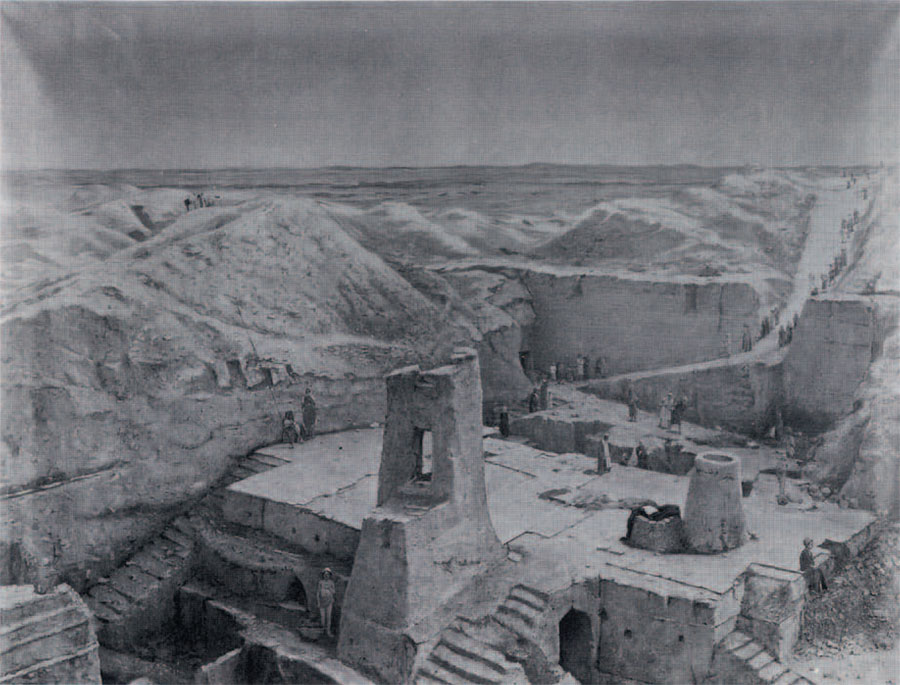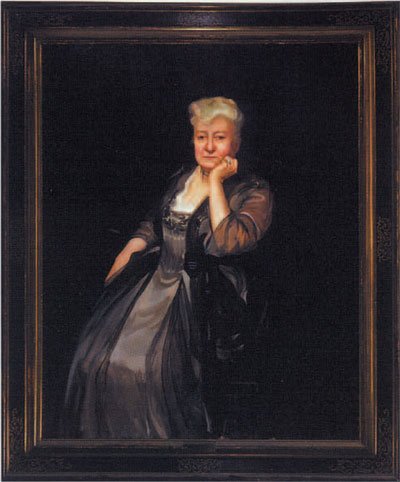
The University of Pennsylvania Museum is not known for its collections of oil paintings, but the Archives displays a few portraits of in-house celebrities and beloved patrons and an imposing view of the Museum’s first major excavation at the Mesopotamian site of Nippur. The paintings sustained damage in a steam pipe explosion that occurred in the Archives last Spring, but have now been beautifully restored by two professional conservators, Carol Abercauph and Howard Serlick. Abercauph repaired the canvases and cleaned the paint, while Serlick restored and regilded the frames. In addition, the Archives have themselves been cleaned and painted. The staff welcomes visitors to view this collection of early Museum pioneers.
The painting of Nippur, a grand, surreal landscape of strange architectural shapes rising out of the ground amid endless desert in the distance, was made in 1903 by Osman Hamdi (1842-1910), a Turkish painter of renown. Trained in Paris, Hamdi was also Director of the Imperial Ottoman Museum (now the Istanbul Archaeological Museum), founder and Director of the Fine Arts Academy in Istanbul, and the Director General of Antiquities for the Ottoman Empire, as well as an archaeologist of note. He developed a close friendship with Herman Hilprecht, first Curator of the Museum’s Babylonian Section and Scientific Director of the Nippur Expedition, for whom the painting was made. In fact, the figure of Hilprecht was added in the right middle-ground after the painting was finished.

Sara Yorke Stevenson (1847-1921) sat for her portrait in 1917 at the age of seventy. It was a fitting tribute to her long life of service to the Museum and Philadelphia. Her accomplishments are too many to list here, but the University of Pennsylvania Museum was her first and lasting love. A founder of the institution, she served as first Curator of the Egyptian and Mediterranean Sections, was President of the Board of Managers, and the principal force behind the construction of the Museum building. The Museum commissioned the painting from Leopold Seyffert (1887-1956), a successful portrait painter trained at the Pennsylvania Academy of Fine Arts (PAFA). Stevenson is portrayed as a strong, dignified woman. Seyffert originally painted the background with an Egyptian theme consisting of palm trees and open sky for an exhibition at the PAFA. but later repainted it black before the portrait was hung in the Museum.
Charles Custis Harrison (1844-1929) was Provost of the University of Pennsylvania from 1894 to 1911. and afterwards devoted himself entirely to the Museum, serving as Vice-President and President of the Board of Managers until his death. He was one of the Museum’s most devoted patrons, and the Harrison Rotunda is named in his honor. Julian Russell Story (1857-1919) painted many prominent people and was regarded as a portraitist of genius. His painting of Harrison wearing academic robes was presented to the Museum by members of his family in 1955. The portrait captures Harrison’s stern yet boyish face.
Eckley Brinton Coxe, Jr. (1872-1916) , heir to coal-mining wealth and President of the Board of Managers (191o-1916), was a modest, deliberate, and exceptionally generous benefactor. He was interested in ancient Egyptian civilization and financed expeditions to Nubia and Egypt. The Coxe Egyptian Wing now bears his name. Coxe was painted by Adolphe Boric (1877-1934), a renowned Philadelphia artist known for his sensitive portraiture. Coxe is depicted with one of his favorite Museum pieces. a steatite statuette of Merer (the “Gardener”) discovered in Nubia.
Maxwell Sommerville (1829-1904) is pictured with pieces from his wonderful gem collection. He made his fortune in publishing, then devoted the rest of his life collecting in two disparate fields, Buddhist art and furnishings and Classical engraved gems. He established a Museum gallery devoted to a Buddhist temple, in which he greeted visitors dressed in Buddhist robes and invited followers of that faith to worship. He became the University of Pennsylvania’s first and only Professor of Glyptology (the study of engraved gems). His portrait was painted by Stephen Ferris (1835-1915), a popular Philadelphia painter and etcher.
Alex Pezzati
Reference Archivist
